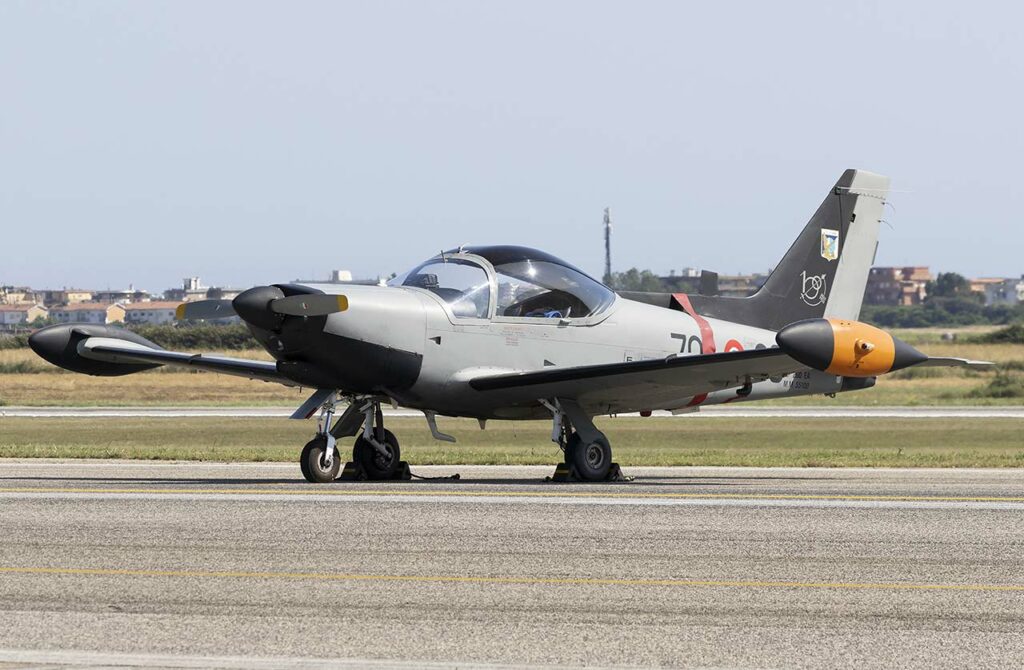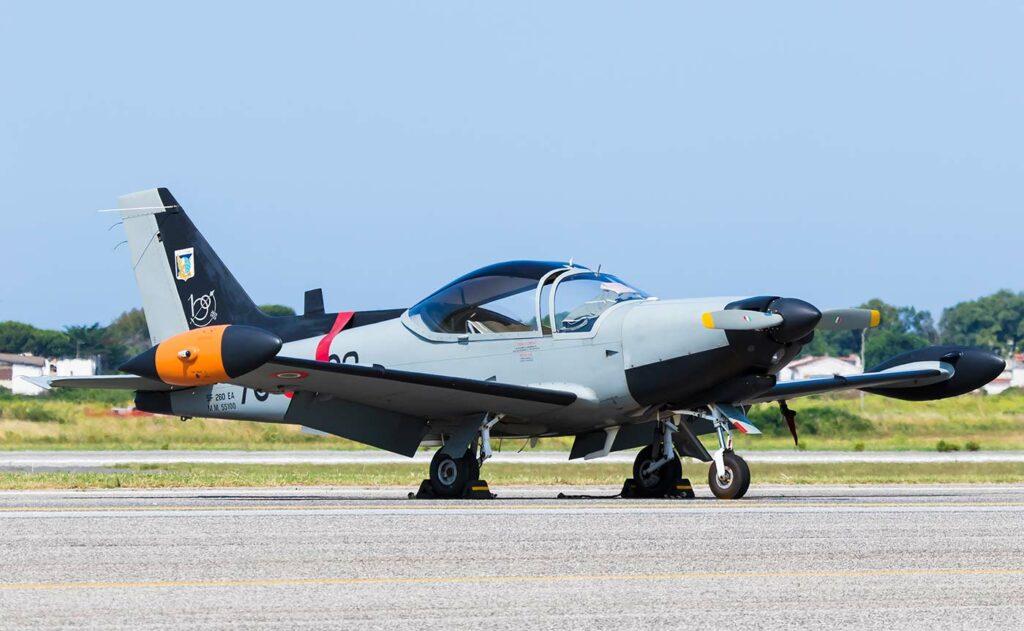The Leonardo SF.260, originally SIAI-Marchetti, is a versatile, high-performance trainer and light combat aircraft known for its agility and efficiency.
In brief
The Leonardo SF.260, initially developed by SIAI-Marchetti, is a light aircraft celebrated for its exceptional handling, aerobatic capabilities, and versatility. Initially designed in the early 1960s as a civilian sport plane, it quickly garnered interest from military operators for its potential as a trainer and light combat aircraft. The SF.260 is powered by a single Lycoming O-540-E4A5 engine, delivering 260 horsepower, which drives a two-bladed constant-speed propeller. It features a low-wing, all-metal design with retractable landing gear and accommodates one pilot and up to two passengers. Over the years, it has been utilized in various roles, including basic training, aerobatics, and light attack missions, by numerous air forces worldwide.
The Leonardo (originally SIAI-Marchetti) SF.260 is an iconic aircraft, primarily recognized for its dual utility as a military trainer and a light attack platform. Its development marks a significant phase in aviation, combining Italian design elegance with practical military and civilian applications.

History of the Development of the Leonardo (SIAI-Marchetti) SF.260
The SF.260 was designed by the Italian aerospace engineer Stelio Frati, initially for Aviamilano, which flew the first prototype in July 1964 before SIAI-Marchetti took over the production. The aircraft was initially intended as a civilian sport and aerobatic plane but was quickly identified as an ideal military trainer due to its superior performance and handling characteristics.
The need for a cost-effective, reliable, and versatile trainer aircraft was evident in the 1960s, as many air forces sought to modernize their fleets and enhance pilot training programs. The SF.260 filled this niche perfectly, offering an excellent platform for both basic and advanced pilot training, including aerobatics, instrument, tactical, and navigation training.
SIAI-Marchetti, recognizing the military potential, marketed the aircraft to various air forces worldwide, leading to its widespread adoption. The first military version was introduced in the late 1960s, and it wasn’t long before the SF.260 gained a reputation for its robustness, ease of maintenance, and operational versatility. The aircraft doesn’t have a NATO nickname, which is common for non-combatant or light utility aircraft.
Its widespread acceptance and use by military forces underscored the SF.260’s success as a multi-role platform, capable of adapting to various training and light combat roles in different operational environments.
Design of the Leonardo (SIAI-Marchetti) SF.260
The SF.260’s design is a blend of simplicity and efficiency. It features a clean, low-wing monoplane configuration, which contributes to its excellent aerodynamic efficiency and superior handling characteristics, especially in aerobatic flight. The airframe construction is primarily of aluminum alloy, ensuring a light yet robust structure, conducive to both training and light attack missions.
The aircraft is powered by a Lycoming O-540-E4A5 six-cylinder, horizontally opposed engine that produces 260 horsepower, driving a two-bladed, constant-speed propeller. This powerplant is known for its reliability and provides a balance between performance and operational economy. The SF.260 has a cruising speed of around 210 knots and a range exceeding 900 nautical miles with auxiliary fuel tanks, showcasing its capability for extended operations.
The cockpit is designed for three occupants, with the student and instructor seated side-by-side, facilitating effective training and communication. This layout is also advantageous for light combat missions, where visibility and crew coordination are paramount. The aircraft’s avionics suite can be customized according to the operator’s requirements, ranging from basic analog instruments to advanced digital systems, enhancing its flexibility and capability to serve in various roles.
Performance of the Leonardo (SIAI-Marchetti) SF.260
The SF.260’s performance metrics are impressive, particularly considering its classification as a light aircraft. It can reach a top speed of approximately 270 mph (235 knots) and has a service ceiling of 19,000 feet, enabling it to operate effectively in a range of conditions and environments. Its agility and responsiveness make it an ideal platform for training pilots in complex maneuvers and combat tactics, as well as for conducting light attack and reconnaissance missions.
Compared to its contemporaries, such as the Beechcraft T-6 Texan II or the Pilatus PC-9, the SF.260 holds its own, especially in the realm of handling and aerobatic capabilities. While it may not match the turbo-prop powered trainers in terms of speed and altitude, its simplicity, lower operating costs, and robust design offer a unique set of advantages that are highly valued, particularly in the context of light attack and comprehensive pilot training.
Variants of the Leonardo (SIAI-Marchetti) SF.260
The SF.260 has seen various iterations and modifications throughout its production life. Key variants include:
- SF.260A: The initial production model, primarily used for civilian and aerobatic flying.
- SF.260M: A military version featuring enhanced avionics and provisions for light armament.
- SF.260D: The most produced variant, with an upgraded engine and improved avionics.
- SF.260EA: A modernized version specifically tailored for the Italian Air Force, featuring advanced avionics.
Each variant brought incremental improvements, catering to the evolving requirements of both military and civilian operators, enhancing the aircraft’s versatility and operational capabilities.

Military Use and Combat of the Leonardo (SIAI-Marchetti) SF.260
The SF.260 has been adopted by numerous air forces worldwide for a variety of roles, from basic training to light combat missions. Its military significance lies in its dual-role capability, where it serves as an effective trainer and, when needed, a light attack aircraft. The aircraft can be armed with machine guns, rocket pods, or light bombs, making it suitable for close air support, counter-insurgency, and reconnaissance missions.
In combat scenarios, the SF.260 has been used by some countries as a counter-insurgency aircraft, where its low operational costs, ease of maintenance, and effective performance in light attack roles have been particularly valuable. Its use in conflicts, such as by the Zimbabwe Air Force during the Mozambican Civil War and other African conflicts, underscores its reliability and effectiveness in combat operations.
Despite facing competition from more advanced training and light attack aircraft over the years, the SF.260 continues to be in service with various military forces, testament to its enduring utility and adaptability to diverse operational requirements.
The Leonardo SF.260, with its roots in SIAI-Marchetti’s innovative design, stands out as a testament to enduring engineering excellence and operational versatility. Its evolution from a civilian aerobatic aircraft to a valued military trainer and light combat aircraft highlights its adaptability and efficiency. The SF.260’s legacy is defined by its exceptional performance, ease of operation, and multi-role capabilities, securing its place in the annals of aviation history as a remarkable aircraft that bridges the gap between training and operational readiness in military aviation.
Back to the Trainers section.